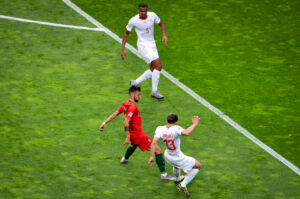Planning and programming in football training are concepts that run in parallel, but each play a unique and essential role in youth development. While planning sets the long-term and short-term objectives and structure, programming brings this structure to life through specific training modalities.
Why is programming essential in the training of football?
Programming stands as a coherent bridge between the objectives outlined in sessions throughout a season, providing a structured guide for progress (Sans and Frattarola, 2009).
This process becomes a tool for progressive and structured learning of content, adapting to the individual characteristics and growth of young players.
Key criteria for programming:
Prioritise Training Content:
- The theory of the Zones of Development (ZdD) is essential in the selection of content. In order to choose the training content, it will be necessary to use the observation of the real game, prioritising content that belongs to the previous sub-stage or that has not been consolidated correctly, with 3 prioritised content to be improved every two months (IBF and CBF).
- The choice of content is in line with the theory of ZDs, which associates each content with a stage of development and competition, ensuring that players focus on specific areas according to their level and skill.
Order the Content:
- The content can be organised according to strategic role: attacker with the ball, attacker without the ball, defender and team.
- The classification according to strategic roles allows for a more specific view, highlighting the skills needed for different roles within the play.
Sequence the Content:
- The vertical (monthly) and horizontal (role) sequence seeks to maximise playing situations, promoting meaningful learning. This is done to maximise the appearance of situations as much as possible (vertical) by bringing together two types of content, preferably from different roles, and they are set against each other (situation) and at the best possible moment (horizontal), i.e. before training this one, one has been trained that helps the assimilation of this one, thus producing more situations that guarantee significant learning.
- The sequencing of content aims to encourage the emergence of playing situations that reinforce learning, connecting skills from different roles for a more complete understanding of the play.
Connect the Blocks of Content
- The strategic link between blocks has to be the one that most helps the acquisition of the desired learning. Which ones? The objective of the session. Therefore, it is necessary to create links between blocks that always act in the session.
- Coordinative skills will always precede, during the activation phase of the training session, the work on Individual Basic Fundamentals with the ball.
- Perceptual skills will precede, also during the activation phase, the work on the Individual Basic Fundamentals without the ball because, although all the Basic Fundamentals require perception, they are linked to those individual ones that are of greater perceptual complexity, where contextual awareness has to be very high – the Individual Fundamentals without the Ball.
- Space management skills which, being content that refers to the whole team and helps to generate collective awareness in the use of space, will precede the work on the Collective Fundamentals.
- The connection between blocks ensures a logical and coherent progression, where coordination, perceptual and space management work complements and reinforces the basic fundamentals.
Timing the Content:
- The number of training days is often premeditated by different factors in the football context, such as the availability of the football pitch, the schedules proposed by the club and the frequency of competitions in each of the federation’s tournaments. Taking into account the above, MBP considers that 3 days is sufficient for this initiation period.
- A minimalist approach is proposed: to work only on one complementary and one basic content and with a single concept for each of them. In this way, the player’s attention will be better focused on what is intended to be trained. Therefore, 4 complementary concepts and 4 tactics (Basic Individual or Collective Fundamentals) per month/content will be trained.
Conclusion
The five steps not only guide the daily practice, but also chart the way during the season for the continuous development of the players in an optimal way. They are the keys that open the door to a more solid training and a deeper understanding of the game.








